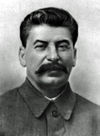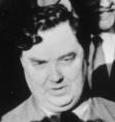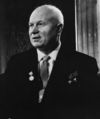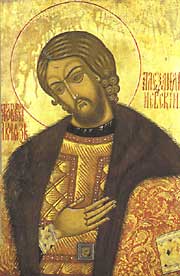List of leaders of the Soviet Union
| Leader of the Soviet Union | |
|---|---|
|
|
|
 |
|
| Union coat of arms | |
_186420.jpg) |
|
| Last leader: Mikhail Gorbachev (as President) |
|
| First leader(s) | Vladimir Lenin (as Premier) |
| Last leader(s) | Mikhail Gorbachev (as President) |
| Appointer | Politburo, Central Committee or any government or party apparatus |
| Communist rule started | November 8, 1917 |
| Communist rule ended | December 26, 1991 |
Under the Constitution of the Union of Soviet Socialist Republics (USSR), the Chairman of the Council of People's Commissars (later known as the Council of Ministers) was the head of government[1] and the Chairman of the Central Executive Committee of the USSR (later known as the Supreme Soviet of the Soviet Union) was the head of state.[2] The office of the People's Commissars was equivalent to the office of prime minister,[1] while the office of the Central Executive Committee was equivalent to the office of president.[2] However, after Joseph Stalin's consolidation of power in the 1920s[3] the post of General Secretary of the Central Committee (CC) of the Communist Party of the Soviet Union (CPSU) was synonymous with 'Leader of the Soviet Union'[4] because the post controlled both the Communist Party of the Soviet Union and the Soviet Government.[3] The post of general secretary was abolished under Stalin and later re-created by Khrushchev as First Secretary which was later re-named under Brezhnev as General Secretary. As head of the union government as a whole,[5] the general secretary was the highest political office in the Soviet Union until March 1990.[6] The post of General Secretary lacked clear guidlines of succession, so after the death or the removal of a Soviet leader, the successor usually needed the support of the Politburo, the Central Committee or another government or party apparatus to both take and stay in power. The office of President of the Soviet Union was created in March 1990, and replaced the general secretary as the highest political office.[7]
When the office of the president was created, the Congress of People's Deputies voted to remove Article 6 from the Soviet constitution which stated that the Soviet Union was a one-party state and that the Communist Party would retain its leading role in society. This vote weakened the party and the office of the general secretary's hegemony over the USSR and its people.[8] Upon death, resignation, or removal from office of an incumbent president, the Vice President of the Soviet Union would assume the office, though the Soviet Union collapsed before it could have been tried.[9] On three occasions, between Vladimir Lenin's death and Stalin's rise, Stalin's death and Nikita Khrushchev's rise, and between Khrushchev's fall and Leonid Brezhnev's consolidation of power, a collective leadership known as the Troika (meaning "threesome")[10] governed the country, with no single individual holding dictatoral power.[11][12]
Contents |
Leaders
Summary
Lenin was elected Chairman of the Council of People's Commissars on 8 November 1917 by the Russian Congress of Soviets, as such, he declared "Communism is Soviet power plus the electrification of the entire country" in modernising Russia into a twentieth-century country.[13] After coming to power, Lenin quickly signed a peace treaty with Germany via the Treaty of Brest-Litovsk, losing much of its European territory to Germany.[14] After a failed assination attempt, Lenin's popularity was on the rise,[15] but his health, as a 53-year-old man, declined from the effects of two bullet wounds, later aggravated by three strokes which culminated to his death in 1924.[16] However, Lenin was already losing power in 1922 to Joseph Stalin when he took the post of general secretary and later when Lenin went into semi-retirement.[17] After consolidating power, Stalin pushed for rapid industrialization[18] and the collectivization of private plots created under Lenin.[19] Stalin, as head of the Politburo, consolidated near-absolute power in the 1930s with a Great Purge of the party, justified as an attempt to expel 'opportunists' and 'counter-revolutionary infiltrators'.[20] In 1941, Nazi Germany invaded the Soviet Union,[21] but they were eventually repulsed and what was to follow was a communist takeover of Eastern Europe.[22] Stalin died in office in March 1953.[23] Stalin's death left a power vacuum which led to a struggle for power between Lavrenti Beria, Georgy Malenkov and Vyacheslav Molotov. At the death of Stalin, the majority within and outside the party believed these three to be the ruling triumvirate, in Russian, Troika.[24] Malenkov left his office in the Central Committee after becoming Chairman of the Council of Ministers,[25] which would prove to be a strategic mistake because the Communist Party would prove that it controlled both the government and the party, something Nikita Khrushchev understod.[26] Malenkov was the leading figure of Soviet politics for little more than a year, chairing meetings not only for the Council of Ministers, but also the Central Committee,[27] while his position seemed secure at the start, his underestimation of the party machine led to his downfall in 1955.[28]
After consolidating power, Khrushchev denounciated Stalin both in 1956 and 1962. His attacks on Stalin (known as de-Stalinization) led to a backlash against him after the events in East Europe in 1956; in particular, growing unrest in Poland and the Hungarian revolution. What follow was an organized anti-Khrushchev group within the CPSU,[29] later known as the Anti-Party Group. The Anti-Party Group was a minority, with Khrushchev having control of both the secret police and the Soviet army and having majority support from the Presidium. Khrushchev's was more or less secure.[30] Khrushchev was removed as First Secretary in 1964, on the basis that he had indulged in tendencies like those seen under Stalin.[31] Leonid Brezhnev, a close companion of Khrushchev, was elected First Secretary the same day of Khrushchev's removal from office, with Alexey Kosygin taking the office of Premier and Anastas Mikoyan as Chairman of the Presidium, he was soon replaced with Nikolai Podgorny because he wanted Khrushchev to retain the role of Premier during his ousting.[12] The 1960s would see the dominant role in Soviet politics go to the so-called collective leadership, better known as Troika,[32] with Henry A. Kissinger falsely believing that Kosygin was the 'Leader of the Soviet Union'.[33] Brezhnev's tenure as leader is best-known for starting the chain reaction which led to the collapse of the Soviet Union in 1991, hence, being called the 'Era of Stagnation' and the Brezhnev stagnation by Mikhail Gorbachev and numerous historians.[34] Brezhnev was followed by Yuri Andropov, who controlled the Soviet Union during his short tenure from the hospital bed, and later Constantine Chernenko, who ruled for little less than a month.[35]
On March 11, 1985, the day following Chernenko's death, Mikhail Gorbachev was elected general secretary by the politburo.[36] In 1985, Gorbachev was alone in the politburo on serious reforms regarding the political and economic systems, however, he promoted several knite members to top party and government offices.[37] In 1988 he abolished all economic departments of the CPSU, in belief that it was the duty of the Council of Ministers, and not the party, to take care of the Soviet economy. By the mid-to-late 1980s, Gorbachev launched the policies of perestroika (literally meaning "reconstruction", but varies) and glasnost ("openness" and "transparency") among others.[38] 1988 and 1989 saw the dissmantling of the principal defining features of communism in the Soviet Union which unintended led to the break-up of the Soviet state into 15 successor states after the failed August Coup of 1991.[39]
List
This list includes only those persons who were able to gather enough support from the Communist Party of the Soviet Union (CPSU) and the government, or one of these to rule the Soviet Union. Because political offices varied in strength in different period, such as the General Secretaryship under Stalin and Gorbachnev, there has been much discussion on who the leader of the Soviet Union 'really' was.
| Leaders | Started | Ended | Notes | |
|---|---|---|---|---|
 |
Vladimir Lenin [40] |
November 8, 1917 [40] |
January 21, 1924 [17] |
[I] |
| Troika [41] |
Grigory Zinoviev [41] Joseph Stalin [41] Lev Kamenev [41] |
1922 [41] |
1925 [41] |
[II] |
 |
Joseph Stalin [17] |
April 3, 1922 [17] |
March 5, 1953 [42] |
[III] |
 |
Georgy Malenkov [43] |
March 5, 1953 [43][11] |
February 8, 1955 [28] |
[IV] |
| Troika [11] |
Georgy Malenkov [44] Lavrentiy Beria [44] Vyacheslav Molotov [44] |
March 13, 1953 [11] |
June 26, 1953 [45] |
[V] |
 |
Nikita Khrushchev [46] |
September 7, 1953 [46] |
October 14, 1964 [47] |
[VI] |
| Troika [47] |
Alexey Kosygin [12] Anastas Mikoyan [12] Nikolai Podgorny [12] Leonid Brezhnev [12] |
October 14, 1964 [47] |
June 16, 1977 [12] |
[VII] |
.jpg) |
Leonid Brezhnev [47] |
October 14, 1964 [47] |
November 10, 1982 [48] |
[VIII] |
| Yuri Andropov [49] |
November 12, 1982 [49] |
February 9, 1984 [50] |
[IX] | |
| Konstantin Chernenko [51] |
February 13, 1984 [51] |
March 10, 1985 [52] |
[X] | |
 |
Mikhail Gorbachev [52] |
March 11, 1985 [52] |
December 25, 1991 [53] |
[XI] |
See also
- Heads of state of the Soviet Union
- Heads of government of the Soviet Union
- List of Presidents of the Russian Federation
Notes
- I^ Chairman of the Council of People's Commissars and informal leader of the Bolsheviks since their inception.[40] Was leader of the Russian Soviet Federative Socialist Republic until the founding of the Union of Soviet Socialist Republics in 1922.[54]
- II^ With Lenin increasingly sidelined throughout 1922, Stalin (elevated to the newly created position of the Central Committee General Secretary earlier in the year), Grigory Zinoviev and Lev Kamenev formed a troika (triumvirate) to ensure that Trotsky, publicly the number two man in the country and Lenin's heir presumptive, would not succeed Lenin.[41]
- III^ General Secretary of the Central Committee of the All-Union Communist Party of Bolsheviks from 3 April 1922 until the office of general secretary was abolished in 1934.[55] From 1934 to March 5, 1953 he was a Secretary of the Central Committee (CC). He served as Chairman of the Council of Ministers of the USSR from May 6, 1941 until his death on March 5, 1953.[42] He also held the post of the Ministry of Defense of the USSR from July 19, 1941 to March 3, 1947 and Chairman of the State Defense Committee during the Great Patriotic War[56] and became the only one to hold the office of People's Commissariat of Nationalities from 1921–1923.[57]
- IV^ Served as First Secretary of the Central Committee of the Communist Party of the Soviet Union but left after taking the position of Premier, which lasted from March 6, 1953[58] to February 8, 1955.[59]
- V^ The first Troika consisted of Georgy Malenkov, Lavrentiy Beria, and Vyacheslav Molotov[44] and lasted until the death of Beria.[60]
- VI^ Served as First Secretary of the Central Committee of the Communist Party of the Soviet Union and Chairman of the Council of Ministers of the USSR from March 27, 1958 to October 14, 1964. Khrushchev was removed from power after a trip to Scandinavia by Leonid Brezhnev and his supporters.[61]
- VII^ The Troika consisted of Brezhnev as First Secretary, Alexey Kosygin as Premier and Anastas Mikoyan as Chairman of the Presidium of the Supreme Soviet of the USSR, however was he replaced by Nikolai Podgorny because of his views on the handling of Khrushchev's removal. After gradually consolidating power, the Troika was dissolved when Brezhnev took the post of Chairman of the Presidium of the Supreme Soviet of the USSR in 1977.[12]
- VIII^ Served as First Secretary of the Central Committee of the Communist Party, was later re-named General Secretary,[62] and later Chairman of the Presidium.[12]
- IX^ General Secretary of the Central Committee of the Communist Party[63] and Chairman of the Presidium from June 16, 1983 to February 9, 1984.[64]
- X^ General Secretary of the Central Committee of the Communist Party[65] and Chairman of the Presidium from April 11, 1984 to March 10, 1985.[66]
- XI^ Served as General Secretary of the Central Committee of the Communist Party from March 11, 1985,[67] and resign on August 24, 1991[68], Chairman of the Presidium of the Supreme Soviet of the USSR from October 1,[65] 1988 until the office was re-named to the Chairman of the Supreme Soviet of the USSR on May 25, 1989 to March 15, 1990[67] and President of the Soviet Union from March 15, 1990[69] to December 25, 1991[70] when he resigned as President, the following the day the Soviet Union was formally dissolved.[53]
References
- ↑ 1.0 1.1 Armstrong 1986, p. 169
- ↑ 2.0 2.1 Armstrong 1986, p. 165
- ↑ 3.0 3.1 Armstrong 1986, p. 98
- ↑ Armstrong 1986, p. 93
- ↑ Ginsburgs, George; Ajani, Gianmaria; van den Berg, Gerard Peter (1989). Soviet Administrative Law: Theory and Policy. Brill Publishers. p. 500. ISBN 0792302885. http://books.google.com/books?id=TT4jrxORoXIC&dq.
- ↑ Armstrong 1989, p. 22
- ↑ Brown 1996, p. 195
- ↑ Brown 1996, p. 196
- ↑ Brown 1996, p. 275
- ↑ Tinggaard Svendsen, Gert; Haase Svendsen, Gunnar Lind (2009). Handbook of Social Capital: The Troika of Sociology, Political Science and Economics. Edward Elgar Publishing. p. 460. ISBN 1845423232. http://books.google.com/books?id=fOMUwqb9AIUC&pg.
- ↑ 11.0 11.1 11.2 11.3 Service 2009, p. 332.
- ↑ 12.0 12.1 12.2 12.3 12.4 12.5 12.6 12.7 12.8 Brown 2009, p. 402.
- ↑ Lenin, Vladimir (1920). Collected Works. 31. p. 516. http://marxists.catbull.com/archive/lenin/works/cw/volume31.htm.
- ↑ Read, Christopher (2005). Lenin: A Revolutionary Life. Routledge. p. 212. ISBN 0415206480. http://books.google.com/books?id=x5zm2EYUj4MC&dq.
- ↑ Volkogonov, Dimitri. Lenin: A New Biography. Free Press. p. 229. ISBN 0-02-933435-7. http://www.amazon.com/Lenin-New-Biography-Dmitri-Volkogonov/dp/0029334357.
- ↑ Clark, William (1988). Lenin: The Man Behind the Mask. Faber and Faber. p. 373. ISBN 0571139043. http://books.google.com/books?id=HbRoAAAAMAAJ&dq.
- ↑ 17.0 17.1 17.2 17.3 Brown 2009, p. 59.
- ↑ Brown 2009, p. 62.
- ↑ Brown 2009, p. 63.
- ↑ Brown 2009, p. 72.
- ↑ Brown 2009, p. 90.
- ↑ Brown 2009, p. 148.
- ↑ Brown 2009, p. 194.
- ↑ Brown 2009, p. 227.
- ↑ Brown 2009, p. 231.
- ↑ Brown 2009, p. 232.
- ↑ Brown 2009, p. 232.
- ↑ 28.0 28.1 Brown 2009, p. 233.
- ↑ Brown 2009, p. 245.
- ↑ Brown 2009, p. 246.
- ↑ Service 2009, p. 378.
- ↑ Bacon and Sandle 2002, p. 13.
- ↑ Brown 2009, p. 403.
- ↑ Brown 2009, p. 398.
- ↑ Brown 2009, p. 481.
- ↑ Brown 2009, p. 487.
- ↑ Brown 2009, p. 487.
- ↑ Brown 2009, p. 489.
- ↑ Brown 2009, p. 503.
- ↑ 40.0 40.1 40.2 Brown 2009, p. 53.
- ↑ 41.0 41.1 41.2 41.3 41.4 41.5 41.6 "Leon Trotsky: Behind the Kremlin Walls (1939)". Marxist Internet Archive. http://www.marxists.org/archive/trotsky/1939/xx/kremlin.htm. Retrieved May 20, 2010.
- ↑ 42.0 42.1 Service 2009, p. 323.
- ↑ 43.0 43.1 Service 2009, p. 331.
- ↑ 44.0 44.1 44.2 44.3 Marlowe, Lynn Elizabeth (2005). GED Social Studies: The Best Study Series for GED. Research and Education Association. p. 140. ISBN 0738601276. http://books.google.com/books?id=NUHU3om46M4C&dq.
- ↑ Andrew, Christopher; Gordievsky, Oleg (1990). KGB: The Inside Story. HarperCollins Publishers. pp. 423–424. ISBN 0-06-016605-3.
- ↑ 46.0 46.1 Taubman 2003, p. 258.
- ↑ 47.0 47.1 47.2 47.3 47.4 Service 2009, p. 377.
- ↑ Service 2009, p. 426.
- ↑ 49.0 49.1 Service 2009, p. 428.
- ↑ Service 2009, p. 433.
- ↑ 51.0 51.1 Service 2009, p. 434.
- ↑ 52.0 52.1 52.2 Service 2009, p. 378.
- ↑ 53.0 53.1 Gorbachev, Mikhail (1996). Memoirs. University of Michigan: Doubleday. p. 711. ISBN 0385480199. http://books.google.com/books?id=MktpAAAAMAAJ&q.
- ↑ Sakwa, Richard (1999). The Rise and Fall of the Soviet Union, 1917–1991: 1917–1991. Routledge. p. 140–143. ISBN 9780415122900. http://books.google.com/books?id=EoQXhV8XTFUC&dq.
- ↑ Service 2009, p. 325.
- ↑ Green, William C.; Reeves, W. Robert (1993). The Soviet Military Encyclopedia: P–Z. University of Michigan: Westview Press. p. 196. ISBN 0813314321. http://books.google.com/books?id=rw3cAAAAMAAJ&q.
- ↑ Service, Robert (2005). Stalin: A Biography. Harvard University Press. p. 154. ISBN 0674016971. http://books.google.com/books?id=hSWK6Dh4wRgC&dq.
- ↑ L. Hill, Kenneth (1993). Cold War chronology: Soviet–American relations, 1945–1991. University of Michigan: Congressional Quarterly. p. 61. ISBN 0871879212. http://books.google.com/books?id=wv91AAAAMAAJ&q.
- ↑ A. Cook, Bernard (2001). Europe since 1945: an encyclopedia, Volum 1. Taylor & Francis. p. 163. ISBN 0815340575. http://books.google.com/books?id=ox_gXq2jpdYC&dq.
- ↑ Taubman 2003, p. 258.
- ↑ Service 2009, p. 376.
- ↑ Service 2009, p. 378.
- ↑ Brown 2009, p. 403.
- ↑ Paxton 2004, p. 234
- ↑ 65.0 65.1 Europa Publications Limited (2004). Eastern Europe, Russia and Central Asia. Routledge. p. 302. ISBN 1857431871. http://books.google.com/books?id=NI1G_9j1AhcC&dq.
- ↑ Paxton 2004, p. 235
- ↑ 67.0 67.1 Paxton 2004, p. 235
- ↑ Service 2009, p. 503.
- ↑ Paxton 2004, p. 236
- ↑ Paxton 2004, p. 237
Bibliography
- Armstrong, John Alexander (1986). Ideology, Politics, and Government in the Soviet Union: An Introduction. University Press of America. p. 240. ISBN 0819154059. http://books.google.com/books?id=ZH9nkBOxrZQC&dq.
- Brown, Archie (1996). The Gorbachev Factor. Oxford University Press. p. 406. ISBN 978-1-845-95076-5. http://books.google.com/books?id=RUXKGZ2sRm4C&dq.
- Taubman, William (2003). Khrushchev: The Man and His Era. W.W. Norton & Company. p. 871. ISBN 0393324842. http://books.google.com/books?id=8n7zYmshBNgC&dq.
- Sandle, Mark; Bacon, Edwin (2002). Brezhnev Reconsidered. Palgrave Macmillan. p. 233. ISBN 033379463X. http://books.google.ca/books?id=fPZPP6Jv58sC&dq.
- Paxton, John (2004). Leaders of Russia and the Soviet Union: from the Romanov dynasty to Vladimir Putin. CRC Press. p. 254. ISBN 1579581323. http://books.google.com/books?id=k9HIHH8jrQUC&dq.
- Service, Robert (2009). History of Modern Russia: From Tsarism to the Twenty-first Century. Penguin Books Ltd. p. 690. ISBN 0141037970. http://books.google.com/books?id=o8Z1QAAACAAJ&dq.
- Brown, Archie (2009). The Rise & Fall of Communism. Bodley Head. p. 720. ISBN 978-1-845-95076-5. http://books.google.com/books?id=yWQpAQAAIAAJ&q.
External links
|
|||||||||

.jpg)